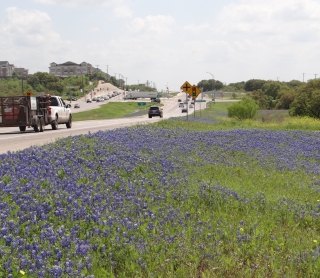Humans have invented ways to transport themselves quickly across vast distances and over otherwise impassable geographical barriers such as mountains, oceans, canyons, and rivers. But it’s not just humans on the move.
Networks of roads and highways have become major pathways for the introduction and spread of non-native invasive species at a rate thousands of times faster than would naturally occur. Wind gusts from vehicles and runoff from roads move weed seeds long distances along the roads, while other invasive species can hitchhike on vehicles into areas where they do not naturally occur. Soil disturbance and movement of materials for highway construction and maintenance activities have further exacerbated this problem by making it easier for invasive species to get a foothold.
Invasive species are one of the greatest threats to the environment, economy, health, and quality of life of people. State Departments of Transportation (DOTs) alone spend millions of dollars each year in invasive species control and mitigation costs, not to mention the disproportionate use of herbicides needed to keep the relentless weeds under control in highway rights-of-way.
Invasive species are one of the greatest threats to the environment, economy, health, and quality of life of peoPLe.
Yet natural resource conservation is not the mission of state transportation agencies, and highway managers’ efforts are stymied by having to operate within certain jurisdictional boundaries, under strict budget constraints, and with a constantly changing list of priority target species to control. Under such circumstances, invasive species management can feel like a bottomless pit of expenditures and complexities, involving various governmental jurisdictions, private landowners, and the general public.
In spite of these challenges, state DOTs can make a difference. Planning ahead, securing funds, and hiring experts to develop an invasive species management program can help DOTs cost effectively mitigate this problem. Preventing the next invasive species can save states millions of dollars in control and mitigation costs.
Show Me the Money
President Clinton’s February 1999 Executive Order 13112 called on Executive Branch agencies to prevent the introduction and spread of non-native invasive species. Up until 2005, implementation of this Executive Order, however, had been a challenge to state DOTs because roadside maintenance activities (including vegetation management) were not eligible for federal aid funds.
In August 2005, a new provision of the Safe, Accountable, Flexible, Efficient, Transportation Equity Act: A Legacy for Users (SAFETEA-LU) for the first time allowed state DOTs to use Federal Highway Administration funds for roadside maintenance activities.
In October 2012, SAFETEA-LU was replaced by a new transportation law, Moving Ahead for Progress in the 21st Century (MAP-21). Under MAP-21, federal aid funds continue to be available for maintenance activities, including invasive species management and native plant establishment. However, MAP-21 restructured and consolidated most of the SAFETEA-LU highway programs.
One of these — the Surface Transportation Program — became more competitive when the repair of structurally deficient bridges was added to the list of activities eligible for funding under MAP-21. Now, environmental projects for native species establishment, invasive species control, and maintenance-related training activities for highways staff must compete for funding with critical bridge repair work.
The Key to Funding: Planning Ahead
To receive federal funds, a project must be part of a state’s Long Range Transportation Plan. Federal law requires states and metropolitan planning organizations to develop plans that cover at least 20 years. These long-range plans identify future transportation needs and establish a vision of how transportation projects will accommodate population growth, local and regional economic development, and associated environmental changes.
Although a 20-year plan may seem far-removed from immediate environmental concerns, planning ahead matters greatly. The assumptions made in developing the long-range plans affect the criteria by which projects are selected for funding. For example, if the long-range plan assumes negative environmental impacts associated with transportation maintenance and construction activities, then the plan may call for strategies to mitigate those impacts.
Every five years states update their long-range plans, from which they derive a list of near-term (four-to-five-year) projects that comprise the state’s Transportation Improvement Program (TIP). States update their TIPs annually, so TIP projects are most likely to advance and get funded at the state level. That also means that every year there is an opportunity to apply for a project’s funding or to move it higher up on the list.
Tips to Help Secure Funding
- Timing is critical. Meet with senior DOT agency staff while draft plans are still being finalized
- Funding for both long-range and TIP projects is constrained by the amount of federal funds available that year, which means that not all listed projects get funded. Given this constraint, certain projects will take priority over others.
- There is considerable flexibility in Surface Transportation Program funds.
- Under MAP-21, states are required to set performance targets, for example, to reduce traffic fatalities and congestion, improve infrastructure and freight networks, or enhance environmental sustainability and eliminate project delays. States must show how their TIP project(s) will help them make progress toward those performance targets. Keep those performance targets in mind when developing TIP projects.
SWCA has invasive species experts who work with DOTs to revamp existing maintenance programs to cost-effectively manage invasive species, as well as provide training and public outreach on invasive species prevention and control. SWCA teams also have expertise in developing long-term invasive species strategic plans that can minimize future ad hoc spending and duplication of effort. We have provided such comprehensive services to the Hawaii Department of Transportation (HDOT) to help them manage one of the most severe invasive species problems in the U.S.
